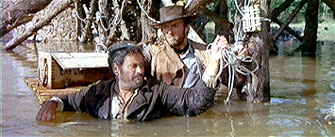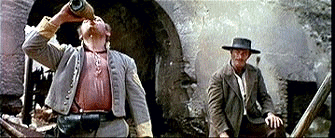| Release List | Reviews | Price Search | Shop | Newsletter | Forum | DVD Giveaways | Blu-Ray/ HD DVD | Advertise |
| Reviews & Columns |
|
Reviews DVD TV on DVD Blu-ray International DVDs Theatrical Reviews by Studio Video Games Features Collector Series DVDs Easter Egg Database Interviews DVD Talk TV DVD Talk Radio Feature Articles Columns Anime Talk DVD Savant HD Talk Horror DVDs Silent DVD
|
DVD Talk Forum |
|
|
| Resources |
|
DVD Price Search Customer Service #'s RCE Info Links |
|
Columns
|
 |
The Good, The Bad |

|
The Good, The Bad and The Ugly Blu-ray MGM Home Entertainment 1966 / Color / 2:35 widescreen (Techniscope) / 187 161, 148 min. / Il Buono, Il Brutto, Il cattivo / Street Date May 12, 2009 / 29.99 Starring Clint Eastwood, Lee Van Cleef, Eli Wallach, Aldo Giuffrè, Luigi Pistilli, Mario Brega, Al Mulock, Aldo Sambrell Cinematography Tonino Delli Colli Production Designer Carlo Simi Film Editors Eugenio Alabiso, Nino Baragli Original Music Ennio Morricone Written by Agenore Incrocci, Furio Scarpelli, Luciano Vincenzoni, Sergio Leone, story by Luciano Vincenzoni, Sergio Leone Produced by Alberto Grimaldi Directed by Sergio Leone |
One of the most popular action westerns around, The Good, The Bad and The Ugly has been released innumerable times on VHS and laserdisc, not to mention three separate DVD editions in this country alone. When I was at MGM it was near the top of the list of "recidivist" home video titles: every seven years another generation comes along that wants to see it. The story of Blondie, Tuco and Angel Eyes has become part of our cultural mythology: Sergio Leone's most popular picture features Ennio Morricone's most recognized score and perhaps Clint Eastwood's most iconic screen character.
GBU received a major restoration in 2003 that turned into a controversy that still hasn't died down. Fans of Leone are well informed about the history and details of all of his films, and most agree that the result has serious drawbacks. Financed partially by AMC cable, the restoration engaged the help of Italian producer Alberto Grimaldi to access the film's original half-frame Techniscope negative, and rebuilt a new 35mm anamorphic master for the film, painstakingly matching each shot. Improved optics pulled a much sharper image from what are essentially two 16mm frames side by side. New theatrical prints were a big improvement over even the Technicolor originals from the 1968 U.S. release.
That aspect of the restoration was uniformly praised, but some revisions to the standard U.S. release were met with a variety of reactions. In 1995 this reviewer was an editor at MGM Home Video. I'd seen a copy of the much longer Italian cut of the film and lobbied in 1998 for the added scenes to be included on the first DVD release. I proposed an idea that had surely been thought of by more than one MGM restoration manager -- that MGM make a longer English-language GBU by recording the missing voices for the "new" scenes. It was an opportunity for MGM to create an exploitable new catalog item, one that perhaps could be re-distributed theatrically.
Nothing happened until 2002 when the restoration deal came through. Project producer John Kirk recorded Clint Eastwood and Eli Wallach, with the late Lee Van Cleef's voice imitated by actor Simon Prescott. In addition to the sixteen minutes of Italian version scenes, Alberto Grimaldi came forward with "The Grotto" scene, a four-minute sequence finished for the film's December 1966 Rome premiere but cut before the first regular Italian theatrical engagements. The Grotto Scene was dubbed and added to the new version as well.
In helping assemble the extras for the 2004 Extended Version Collector's Edition DVD of The Good, The Bad and The Ugly, I soon discovered that key Leone collectors were unhappy with the new restoration. Some of their arguments asserted that nobody should alter Leone's work except Leone. The American release didn't have the extra scenes so they shouldn't be put in. The counter argument to that is that the English-language cut of GBU was already something that Leone didn't control and that he surely didn't finesse. Leone can't have wanted the film to be cut by half an hour, and others supervised the dubbing because of his poor grasp of English.
As for The Grotto scene, Grimaldi insisted that he had forced Leone to cut it, and that he wanted it restored.
Just as debated was the remixing of the film's original mono audio into 5.1 stereo. John Kirk had no choice in the matter as AMC cable and MGM Home Entertainment insisted on a stereo track. As no full set of audio separations existed, the new track ended up being an elaborate reprocess job from mono. When the original sound effects came out sounding weak (or phasing against themselves across channels) the mixers augmented them -- materially changing the film's mix.
This happens all the time with older films, usually with the excuse that an original mono mix version is also provided for reference. No mono mix was included in the restoration budget, so no mono track was available for the DVD.
Everyone agrees that The Good, The Bad and The Ugly is enjoyable under almost any screening conditions; fans made do with pan-scanned VHS tapes for more than ten years, before the advent of laserdiscs. The new Blu-ray is by far the best way to enjoy Leone's genre-altering western landmark. GBU has aged extremely well for a new generation that appreciates it from multiple viewpoints. Leone's visuals are as stylized as those of any graphic novel or anime, and the characters played by Eastwood, Eli Wallach and Lee Van Cleef have taken on much more resonance. Leone and composer Ennio Morricone elevate many sequences to a kind of operatic grandeur, evoking emotions from the western genre unexplored by American films of the time.
As I've reviewed GBU more than once before, I direct readers to my 2004 review of the Extended Version Collector's Edition DVD for a plot synopsis and other observations.
MGM's Blu-ray of The Good, The Bad and The Ugly is distributed by Fox Home Entertainment, which has repackaged the new HD encoding with most of the extras from the fancy DVD release, along with a couple of extras.
Being a Blu-ray, the transfer is indeed brighter and more stable than any DVD could be. GBU was filmed in the cost-cutting Techniscope process, which uses only half of a 35mm frame and should therefore show more grain when enlarged to full anamorphic widescreen. Original dense (and slightly soft) IB Technicolor prints hid some of the grain, and distracted the viewer with rich colors. The new Blu-ray transfer should show more grain structure, more of the "good" kind of grain that gives character to the image and helps delineate objects in the frame. We think -- we're not certain -- that a slight digital enhancement was added. The trade-off is a picture that's not quite as sharp as it could be. GBU on Blu-ray is much sharper than the DVD. The picture looks great, if not fall-out-of-your-chair great, as do discs of many new films.
On the other hand, some the hysterical web criticism I've read is just hooey. Some complainants claim that the picture "looks terrible", and one web poster wailed that it didn't look as good as the 1986, full-35mm, flat movie Ferris Bueller's Day Off, a point of comparison that escapes me entirely.
The Blu-ray packaging lists an extra track in mono English, which we initially took as MGM's alleviating fan objections by finally providing an original mono. To make such a track, one would have to synch up the 1968 mono release audio, and combine it with a monaural fold-down of the new sections of the film. Unfortunately, that's not what has been done -- the entire mono track is simply a fold-down of the new multi-channel mix, sound effects augmentations and all. Why did MGM/Fox bother? At best the mono track is meaningless, and at worst it's a cynical cheat against the faithful Sergio Leone fans. Spanish, French, German and Portuguese tracks are offered in 5.1, and an Italian track (presumably the original) in mono.
The Blu-ray does without the fancy white-box packaging that distinguished the DVD release, and was carried over to the other two "Dollars Films" and Savant's favorite Duck You Sucker. That means that the Blu-ray contains no insert booklet with Roger Ebert's original review, and no set of international poster mini-reproductions.

The commentary track by critic Richard Schickel has been retained. Added for Blu-ray is a new commentary by art historian and Leone biographer Christopher Frayling. When Frayling recorded his commentaries for the other three Leone special editions in 2004 he recorded this track as well, just so it would be available for a future GBU re-issue. MGM did not snub Frayling, and neither did he refuse to record the track. More ill-informed web rumors ...
The original special edition featurettes are intact, looking good bumped up to HD quality. The disc packaging makes Leone's West and The Leone Style seem like unrelated items, but they are a long-form docu divided into two parts, with some wonderful (and funny) input from Eli Wallach and Clint Eastwood. Eastwood seems to be having a grand time and his candor is a highlight of the disc set. Reconstructing ... takes us to John Kirk and the company that performed the new Techniscope restoration. Deleted Scenes looks at the "Tuco Torture" scene and the long-lost "Socorro" sequence, explaining why they can't be restored.

Variety music critic Jon Burlingame gives us a short illustrated overview of Ennio Morricone's vast contribution in Il Maestro .... A second, somewhat redundant Burlingame speech about Morricone is an audio-only extra. Peter Spirer's The Man Who Lost the Civil War is a cut-down of an originally hour-long docu that chronicles the actual West Texas skirmishes that became known as the Sibley campaign.
The Blu-ray does not carry over the DVD poster gallery, but original American and French theatrical trailers are included.
On a scale of Excellent, Good, Fair, and Poor,
The Good, The Bad and The Ugly Blu-ray rates:
Movie: Excellent
Video: Excellent -
Sound: Excellent
Supplements: Richard Schickel commentary, Christopher Frayling commentary, docus Leone's West and Leone's Style, Featurettes The Man Who Lost the Civil War, Reconstructing The Good, The Bad and The Ugly and Il Maestro: Ennio Morricone and The Good, The Bad and the Ugly; uncut Tuco Torture scene, deleted Socorro Scene reconstructed with still photos, two trailers.
Packaging: Keep case
Reviewed: May 24, 2009
Review Staff | About DVD Talk | Newsletter Subscribe | Join DVD Talk Forum
Copyright © MH Sub I, LLC dba Internet Brands. | Privacy Policy | Terms of Use
|
| Release List | Reviews | Price Search | Shop | SUBSCRIBE | Forum | DVD Giveaways | Blu-Ray/ HD DVD | Advertise |





